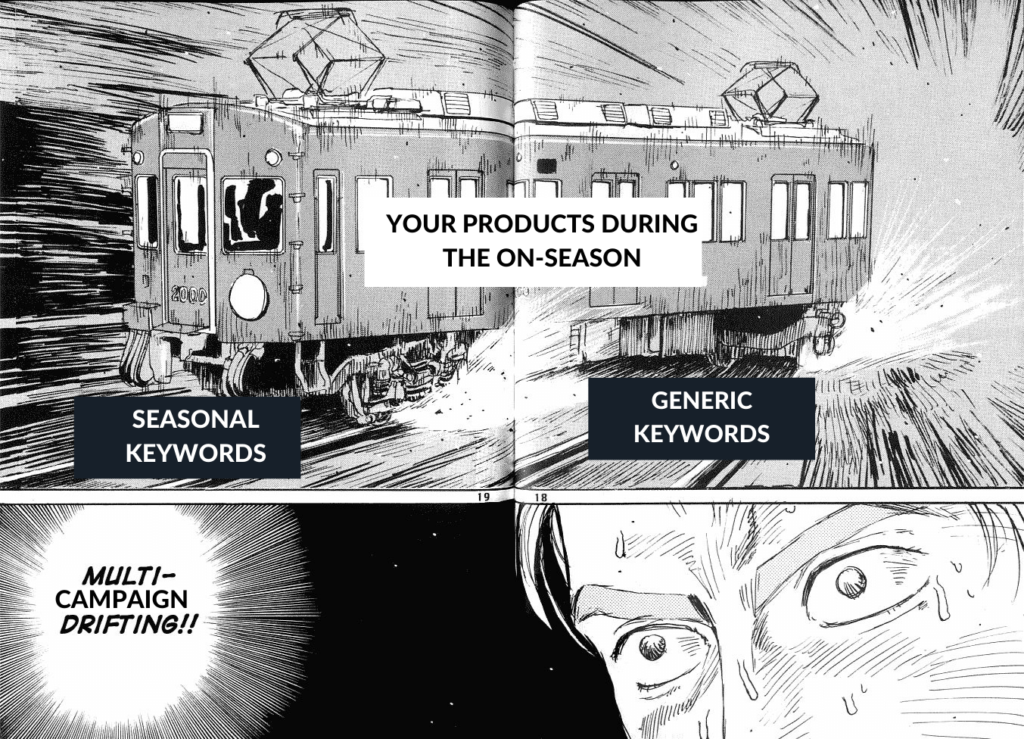Do you find your sales skyrocketing at certain times of the year while staying lower in others? If so, demand for your products is subject to seasonality.
When demand for your product is heavily affected by seasonality, you effectively have to have three different strategies: one for the on-season, one for the off-season, and one for the shoulder season, just before and just after the peak. Seasonality also requires you to take a somewhat different approach to campaign structure, bidding strategies, and more.
This can be tough because you want to be sure you spend money exactly where and when it has the highest chance of netting you clicks and conversions, but with a seasonal cycle, that is subject to change over time. Fortunately, there are a variety of ways to optimize your campaigns with seasonal demand to maximize profits while minimizing wasted ad spend.
Structural Approaches to Amazon Seasonality
There are also different ways to approach seasonality in Amazon Advertising in terms of how you structure your campaigns to respond to it. We’ll talk about two different strategies here.
One option is to only run ads for seasonal products and bid on your seasonal keywords during the on-season. This strategy is best for products that have a very sharp ramp-up and drop-off in their seasonality, as well as products that are unusable by most of the population during the off-season, such as beach chairs.
Another way to work with seasonality in Amazon PPC is to have those seasonal keywords and targets in your normal campaigns, but bid on them more aggressively when the time is right.
Say, for example, you sell those big bags of fun-sized candies for Halloween. Obviously, you’re likely to have much more demand in the weeks leading up to Halloween than during the rest of the year, but you still might have some customers during the off-season.
The good thing about this strategy is that since you only pay when a shopper clicks on your Amazon ad, chances are you won’t be breaking the budget during the off-season. One solid way to take advantage of this is to run auto campaigns during the off-season so that you pick up on the occasional shopper who searches for a seasonal keyword during that time.
In either case, you want custom, structured campaigns for your seasonal products. For the first option, the benefit is you can turn it on and off without affecting your other campaigns. For the second option, the benefit is you can keep an eye on what your seasonal products are doing.
Amazon Seasonality and Budgeting
Proactive Peter
Being a Proactive Peter involves a bit of gambling. It involves making the assumption that at a given point in time, the seasonal cycle will kick in and demand for your product will go up. Of course, the amount of gambling involved depends on how consistent your on-season is and the amount of historical data you have at your disposal.
The Proactive Peter strategy entails increasing bids for all of your seasonal keywords right before demand for your seasonal product starts to climb. If you wait until peak demand is in full swing, you’ll be too late and won’t be able to take full advantage of that demand.
On one hand, this definitely has the potential to give you an early-mover advantage, but on the other hand, if demand is lower than expected or you miscalculate when the demand will start to increase, you could end up with a lower ROAS than you expected.
Responsive Ronald
Being a Responsive Ronald involves looking at your metrics for signs in your Amazon reports that your on-season is about to begin. You might want to lean more into this strategy if your seasonal cycle is less rigid and somewhat unpredictable, as it can help prevent you from wasting money on a false start. On the minus side, it might allow your competitors to get ahead if you don’t recognize the signs in time.

Ideally, your strategy will look like a combination of Responsive Ronald and Proactive Peter in your Amazon PPC campaigns. You should go into your Amazon reports and track your data for seasonal indicators; be prepared to up your bids when the time is right to get ahead of your competition.
Should You Pause Seasonal Campaigns?
Should you put your seasonal campaigns on ice during the off-season then revive them before the next on-season starts?

If you have a “cliff-type” campaign, with very short shoulder seasons and very quick changes in demand, you can keep your seasonal campaigns paused during the off-season without worrying that they’ll be slow to wake up when the time comes. However, you’ll want to unpause it before the on-season officially starts to allow it time to gain traction and take advantage of that shoulder season demand.
Using Seasonal Keywords in Amazon
The complexity of seasonal demand management in Amazon Advertising doesn’t end with campaign structuring and budgeting. You have to be flexible enough to employ different keyword bidding strategies at the same time.
Let’s imagine you have a product that shoppers commonly buy as a gift for their mothers. For a product like this, you have two types of keywords: specific keywords that get a high search volume during the on-season (e.g. “mother’s day gift”), and more generic keywords that maintain a smaller search volume year-round (e.g. “gifts for mom”). Depending on where you are in your seasonal cycle, you have to adjust the balance between these two types of keywords in your account.
You want to be well-aware of how much of your campaign’s ad spend is going to your seasonal keywords, so you can make sure they don’t eat into the potential sales of the more generic keywords. A great way to do this is to have two separate campaigns, one for specific keywords and one for generic keywords. Make sure you give both campaigns descriptive names to not get them confused.

Another plus side to this two-campaign strategy is that you can turn off the specific keyword campaign while still reaping the benefits of your generic keywords during the off-season.
Generic keywords require a more nuanced approach than seasonal keywords. You definitely want to use some sort of bid automation software (cough cough, like cough cough) to automatically adjust your bids while reacting to changes in demand. A responsive strategy is key here to get your campaigns ready to pick up on the increased search volume during the on-season.
Recording and Analyzing Amazon Seasonality
Unfortunately, with that pesky 60-day data cutoff point, Amazon makes it difficult to compare year-over-year seasonality behavior. Fortunately, there are a few workarounds here.
One thing you absolutely should do is download search term reports and bulk file backups of your Amazon campaign data to keep for future reference. These let you go back and look at your past data in much finer detail than in Seller Central, so you can make solid data-driven decisions about your Amazon PPC strategy.
In terms of visualization, lots of Amazon PPC-ers use data visualization programs like Tableau to look at how their seasonal cycles move, anticipate changes, and compare seasons year-over-year.
By the way, Ad Badger lets you look at historical data much further back into the past than Amazon and gives you in-depth reporting on that data to prepare for ongoing seasonal cycles. Just saying.
Key Takeaways
Running Amazon PPC for products with seasonal fluctuating demand requires a different approach and a little more TLC than for products with stable demand throughout the year.
You want to be both proactive and responsive when adjusting your bids on your seasonal products when the time is right. Look for changes in your Amazon reports that signal the start of seasonal changes, but don’t wait for your competitors to move first and steal the limelight.
If your seasonal demand rises and falls quickly, you can pause your seasonal campaigns during the off-season. Just be sure to wake them back up in time to take advantage of the next on-season.
Create two different campaigns for your seasonal products: one for specific keywords that get a large number of impressions only during the on-season, and one for more generic evergreen keywords that get some impressions year-round. For both, employing some kind of automated bid optimization will really help you take advantage of more nuanced demand changes.
Make sure you keep track of your historical seasonal data because Amazon won’t do it for you. Download backups of your bulk files and search term reports to refer to when crafting your strategy for the next on-season.
Now that you’re armed with all of this seasonal knowledge, go forth and conquer your fluctuating demand!

0 Comments